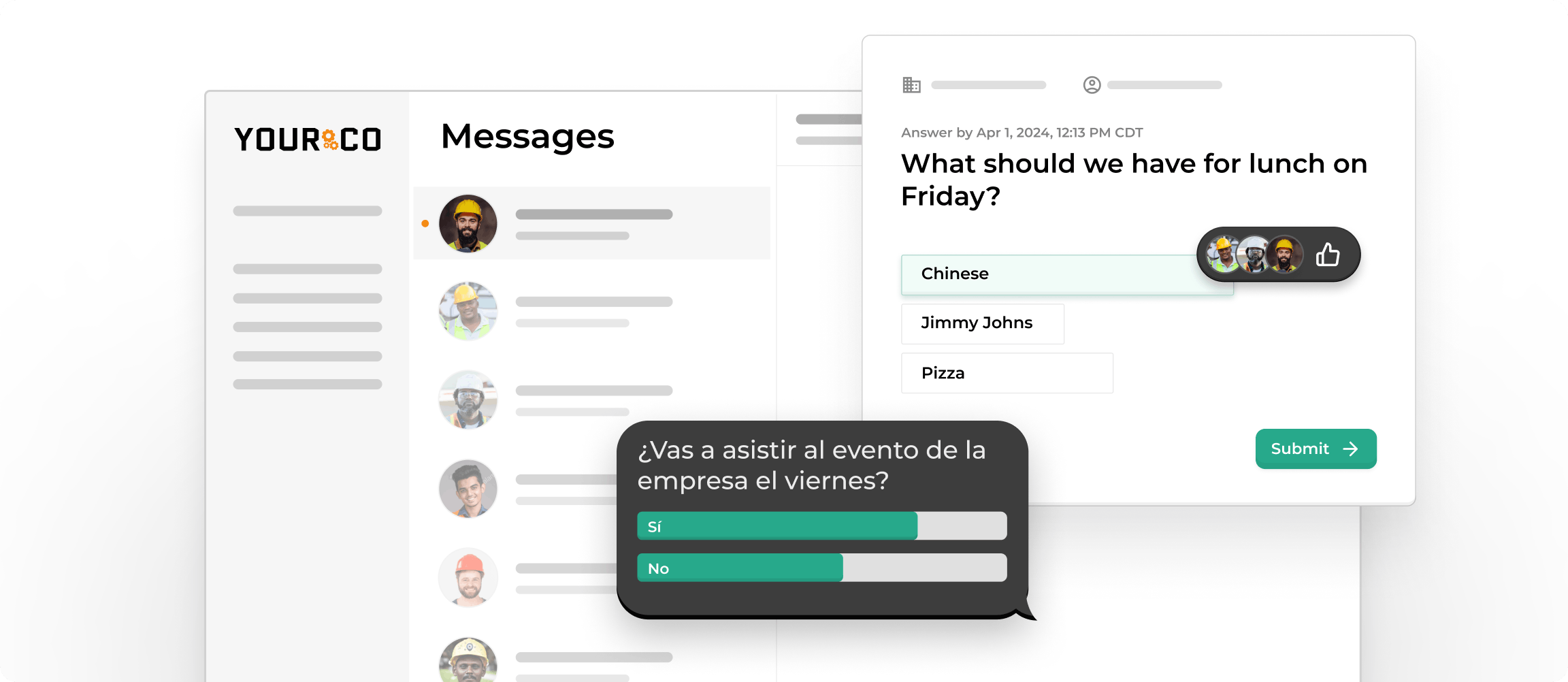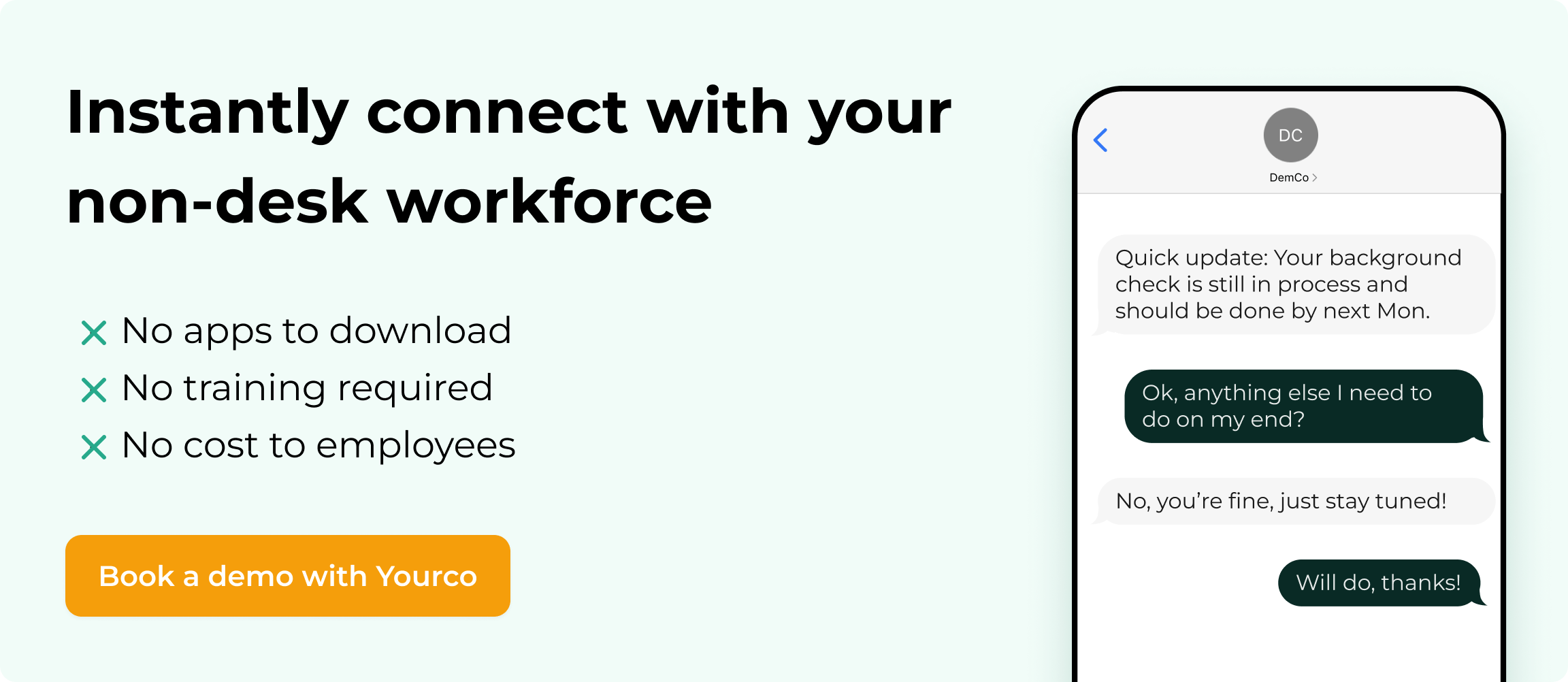How to Master Task Assignment: A 6-Step Workflow That Actually Works


Telling someone what to do seems simple, but let's face it: there's an art to effective task assignment. When you assign tasks poorly, you create a mess of missed deadlines and frustrated team members. When you assign tasks well, you build high-performing teams that drive real business growth. The challenge becomes even trickier when you consider the unique barriers that the majority of workers who don't sit at desks all day face.
Poor task assignment ripples through your organization; it decreases productivity as people struggle with unclear instructions, damages team morale when work feels mismatched, and results in missed deadlines that frustrate customers. These problems affect distributed teams especially hard.
In fact, 80% of the global workforce are non-desk employees working in manufacturing, retail, healthcare, and field services. These workers encounter unique barriers that standard task assignment methods don't address, especially when it comes to onboarding non-desk employees. Most (83%) don't even have business email addresses, making typical digital communication useless.
This guide breaks down a proven 6-step workflow that fixes how you assign, track, and complete work across any team structure. You'll learn how to match the right tasks to the right people, set crystal-clear goals, and monitor progress without constantly checking in. For teams with non-desk employees, we'll show how SMS-based platforms like Yourco connect everyone when traditional tools fall short.
The 6-Step Task Assignment Workflow
Effective task assignment follows a systematic approach that ensures clarity, accountability, and successful completion. This proven six-step workflow transforms chaotic work distribution into a streamlined process that works especially well for distributed teams and non-desk employees. When implemented correctly, this framework has helped manufacturing companies reduce quality defects by 30% through consistent instruction delivery and clear communication channels.
Step 1: Set Clear, Outcome-Focused Goals
Objective: Define exactly what success looks like before anyone starts working. Clear goals eliminate confusion and provide measurable targets for completion.
How-to: Write specific, measurable outcomes rather than vague instructions. Instead of "clean the facility," specify "sanitize all high-touch surfaces in the break room using approved disinfectant, ensuring 15-minute contact time per manufacturer guidelines." Include quality standards, required materials, and completion criteria. Use Yourco's document sharing feature to attach visual guides, checklists, or standard operating procedures that workers can access on their phones.
Common mistake: Assuming everyone understands what "good" looks like. Attach photos of acceptable completion standards or create brief video demonstrations that workers can access directly.
Mini-example: A facilities manager assigns "parking lot maintenance" versus "remove all debris from parking areas A-C, apply line striping to faded spaces, and photograph completed sections for quality verification by 3 PM."
Step 2: Match Tasks to Team Strengths
Objective: Assign the right person to the right work based on skills, experience, and current workload to maximize efficiency and job satisfaction.
How-to: Maintain an updated skills inventory for your team members and consider their preferences when possible. Match complex work to experienced employees while giving newer team members opportunities to develop skills with appropriate support. Use Yourco's polling feature to quickly survey team availability and interest in specific assignments. For non-desk employees, factor in their location, shift schedule, and equipment access.
Common mistake: Always assigning difficult work to your top performers, leading to burnout and resentment. Distribute challenging assignments fairly and provide mentorship opportunities for skill development.
Mini-example: Rather than always asking your most reliable technician to handle emergency repairs, rotate these assignments among qualified team members and pair less experienced workers with mentors for learning opportunities.
Step 3: Communicate Expectations & Context
Objective: Ensure every team member understands not just what to do, but why it matters and how it fits into bigger goals.
How-to: Provide context about how the work connects to customer satisfaction, safety requirements, or business objectives. Utilize effective strategies for communicating to help team members understand updates and new processes. Use Yourco's SMS platform to deliver instructions directly to personal phones. Take advantage of AI-powered workplace translation tools and techniques for ensuring clarity in communication so non-native speakers receive clear instructions in their preferred language.
Common mistake: Sending generic instructions that don't explain the "why" behind the work. Workers perform better when they understand the purpose and impact of their contributions.
Mini-example: Instead of "Replace air filters in units 1-5," explain "Replace air filters in units 1-5 to maintain proper ventilation for our production schedule. Old filters reduce efficiency and can cause equipment failure that delays customer orders."
Step 4: Agree on Realistic Deadlines & Milestones
Objective: Set achievable timelines that account for complexity, available resources, and potential obstacles while maintaining accountability.
How-to: Involve team members in deadline setting when possible, as they often have valuable insights about realistic completion times. Break larger projects into smaller milestones with check-in points. Consider factors like equipment availability, other ongoing work, and potential delays.
Common mistake: Imposing arbitrary deadlines without considering the actual work involved. This leads to rushed work, safety shortcuts, or missed deadlines that damage trust.
Mini-example: For a week-long inventory project, establish daily milestone targets (complete sections A-B by Tuesday, C-D by Thursday) rather than just setting a final Friday deadline.
Step 5: Empower & Support (Resources, Authority)
Objective: Give team members everything they need to succeed, including tools, information, decision-making authority, and access to help when problems arise.
How-to: Clearly define what decisions workers can make independently and when they should escalate issues. Ensure they have access to necessary tools, materials, and reference documents through Yourco's secure document sharing. Establish clear escalation paths for questions or problems, and encourage proactive communication about obstacles.
Common mistake: Delegating work without providing adequate resources or authority, then blaming workers when they can't complete it effectively.
Mini-example: When assigning equipment maintenance, provide not just the checklist but also access to parts inventory, maintenance manuals, and clear guidelines about which repairs they can handle versus which require supervisor approval.
Step 6: Monitor Progress & Give Feedback
Objective: Track completion without micromanaging, provide support when needed, and recognize good work to reinforce positive performance.
How-to: Schedule regular but non-intrusive check-ins based on complexity and worker experience level. Provide specific, actionable feedback that helps improve future performance. Celebrate successful completions to maintain morale and motivation. Use Yourco's read receipts to confirm workers have received instructions, and the polling feature for quick status updates. Taking advantage of automated text messaging benefits allows you to streamline this process and keep your team engaged.
Common mistake: Either ignoring progress completely until the deadline or checking in so frequently that workers feel micromanaged and lose motivation.
Mini-example: For a multi-day project, send a brief SMS asking "How's the equipment calibration going? Any obstacles I can help remove?" rather than demanding detailed hourly updates or waiting until the final deadline to check progress.
This systematic approach transforms task assignment from a source of confusion into a reliable process that keeps teams engaged and productive. The key is adapting each step to your team's specific needs while maintaining consistency in your approach.
Key Factors When Matching Tasks to People
Effective task assignment goes beyond simply distributing work; it requires understanding employee needs and what drives performance and engagement in your team. When you match assignments thoughtfully, you'll achieve higher completion rates, better quality outcomes, and more satisfied employees. This becomes even more critical when you manage non-desk workers who often feel disconnected from organizational decision-making.
Preference
Employee interest drives success more than most managers realize. People who work on assignments they find interesting or meaningful invest more effort and produce better results. Ask yourself: "What types of work energize this person?" and "Which responsibilities do they volunteer for?"
Someone who consistently offers to handle customer complaints likely has both the temperament and skills for service recovery. Pay attention to these patterns, as they reveal natural strengths and motivations that formal evaluations often miss.
Skill and Experience Level
Match task complexity to prevent frustration or failure. Consider not just technical abilities but also soft skills like communication or problem-solving. A senior technician might excel at complex repairs but struggle with training newer employees.
Before assigning any work, ask: "Does this person have the foundational knowledge needed?" and "What's their track record with similar challenges?" Don't assume expertise in one area translates to another. Remember that even your best performers have limits.
Availability
Time and mental capacity both matter when delegating work. Even skilled employees can't deliver quality results when overwhelmed. Check current workloads, upcoming deadlines, and personal circumstances that might affect performance.
Distributed teams and shift workers face unique scheduling constraints that office-based managers often overlook. A factory worker pulling double shifts needs different consideration than someone with a predictable desk schedule.
Priority
High-stakes assignments need your most reliable performers, while routine work can help develop junior team members. Consider both business impact and learning opportunities when making assignments. The key question: "Does the priority match their capability level?"
Critical deadlines aren't the time to experiment with untested team members, but low-risk projects offer perfect development opportunities.
Yourco's platform helps you gather this crucial information through employee surveys, feedback polls, and engagement tools that capture preferences and availability in real-time, aiding in understanding employee needs. Use this quick checklist before any task assignment: Does this person have the necessary skills? Have I checked their current workload? Do they have interest or experience in this area? Is the deadline realistic given their other commitments? Does the priority match their capability level?

Troubleshooting Task Assignment
Even well-intentioned managers can stumble into delegation traps that damage productivity and team morale. Recognizing these pitfalls early helps you course-correct before small issues become major problems.
Overloading Your Star Performers happens when you consistently pile assignments on your most reliable employees. This burns them out and creates resentment among other team members. Track workloads and distribute work based on capacity, not just past performance. Create a rotation system that gives everyone opportunities to tackle challenging projects.
Shifting Deadlines Without Notice breaks trust and disrupts planning. When changes happen, communicate immediately and explain the reasoning. Schedule updates in advance when possible, giving your team time to adjust their priorities accordingly.
Micromanagement starts with good intentions but suffocates autonomy and kills morale. Instead of hovering, establish clear check-in points and focus on outcomes rather than methods. Trust your team to find their path to success.
Ignoring Feedback Loops means missing valuable insights about process improvements and potential issues. Regular pulse checks help you identify problems before they escalate. For non-desk employees, these pitfalls can be especially damaging since communication challenges amplify every mistake.
Yourco's SMS-based platform directly addresses these common pitfalls by ensuring clear instructions reach everyone instantly, enabling scheduled updates about deadline changes, and facilitating quick feedback through polls and surveys without creating a micromanagement culture.
Allocating vs. Delegating: Picking the Right Approach
Understanding when to allocate versus delegate work can transform your team's performance and development. Assignment allocation means you distribute specific work while retaining ownership and control over the outcome. You provide detailed instructions and expect execution according to your specifications. Delegation, however, transfers both the work and ownership to your team member, giving them autonomy to decide how to achieve the desired result.
The key difference lies in three areas: ownership level, autonomy, and feedback style. With allocation, you remain accountable for results and provide step-by-step guidance. Delegation shifts accountability to the employee while you focus on support and periodic check-ins.
Allocation works best for critical deadlines, inexperienced team members, or highly regulated processes where precision matters most. Choose this approach when you need specific methods followed, have tight compliance requirements, or are working with new employees who need structured guidance. Delegation shines when you want to develop skills, have experienced staff, or need to free up your time for strategic work. Use delegation when you trust the person's judgment, want to encourage creative problem-solving, or are preparing someone for increased responsibilities.
Adapting Task Assignment to Team Size & Structure
Different team configurations require tailored approaches to task assignment. Match your strategy to your team's unique dynamics, communication patterns, and operational challenges to fully realize the communication integration benefits.
Small Teams (≤5 people)
Small teams benefit from direct communication and shared accountability. Everyone typically knows each other's strengths and current workload, making work distribution more intuitive. The challenge lies in preventing overload of high performers when resources are limited.
Cross-training team members prevents bottlenecks and ensures coverage during absences. In small teams, informal check-ins often work better than rigid processes, but documentation remains crucial for tracking progress and maintaining accountability.
Large Cross-Functional Teams (10+)
Large cross-functional teams need structured coordination and clear communication channels. Without proper systems, team members often miss important updates, leading to confusion and delays.
Establish clear role definitions, use standardized formats, and implement regular check-ins across departments. Appointing team leads for different functions maintains accountability while preventing communication bottlenecks. Large teams also benefit from centralized tracking systems that provide visibility into workload distribution and progress across all members.
Moreover, traditional email systems often fail to reach non-desk workers. Distance amplifies communication gaps, making it harder to gauge availability, clarify expectations, and provide timely support.
SMS-based platforms like Yourco bridge this gap by delivering task assignments directly to personal devices, ensuring every team member receives critical information regardless of location or device access. This approach works particularly well for distributed teams where members may not have consistent internet access or company-issued devices.
Frequently Asked Questions about Task Assignment
How many tasks should one person handle?
The sweet spot is usually 3-5 active assignments per person, but complexity and experience level matter more than raw numbers. Someone handling routine data entry can juggle more work than someone managing complex project deliverables. Check their current workload and upcoming deadlines before adding anything new.
What if a team member refuses a task?
Start with a direct conversation to understand their concerns; they might lack the right skills, feel overwhelmed, or see conflicting priorities you missed. Address their specific issues first, then either provide additional support, adjust the scope, or reassign to someone better suited.
How do I adjust deadlines mid-project?
Communicate changes immediately and explain your reasoning to maintain team trust. Send updates to all affected team members simultaneously, clearly stating new deadlines and any resource implications. Document the change for future reference and check if anyone needs additional support to meet the revised timeline.
Which metrics prove task assignment is working?
Track completion rates, on-time delivery percentages, and quality scores alongside employee satisfaction with their assignments. Monitor rework frequency and time-to-completion trends to spot improvement opportunities. Also measure team engagement levels and voluntary feedback about clarity and workload balance. Yourco's read receipts and response tracking provide real-time visibility into acknowledgment and completion confirmation, giving you concrete data on what's working.
How often should I review progress?
Match your review frequency to complexity and duration. Daily check-ins work for short-term, critical projects, while weekly reviews suit longer assignments. Monthly assessments help evaluate overall patterns and team performance trends. Balance oversight with autonomy, as frequent communication shouldn't feel like micromanagement.
Taking Your Task Assignment to the Next Level
Effective task assignment is about creating a responsive, engaged workforce that delivers quality results consistently. By applying the six-step workflow we've outlined, you can revolutionize how tasks are assigned, tracked, and completed across your organization, particularly for the non-desk employees who are the backbone of your operations.
At the core of successful task management is clear communication. When your team fully understands what’s expected, why their tasks matter, and how they can seek support, they’ll approach their work with confidence, ownership, and dedication. But achieving this with traditional methods can be a challenge, especially when you’re dealing with distributed teams and non-desk employees who don’t have access to standard digital tools.
That's where Yourco’s SMS platform makes a real difference. With its simple yet powerful functionality, Yourco ensures that every team member, no matter their location or tech access, is always connected. No more missed emails, no more lost messages, and no more confusion about priorities. Yourco’s real-time, direct communication via SMS guarantees that everyone stays aligned and informed, ensuring tasks move forward smoothly.
But we’ve taken it even further to help you streamline task management. With Yourco’s new "Mark read and unread" feature, managers now have enhanced control over task follow-ups and priorities. This feature helps you track which tasks require attention, making it easier to ensure nothing slips through the cracks. By marking tasks as read or unread, leaders can monitor progress and prioritize workloads, helping the team stay on top of deadlines and ensuring that key tasks are completed on time.
With Yourco, task management isn’t just easier, it’s smarter. It's about keeping your team engaged, accountable, and empowered to do their best work.
Ready to see how much more your team can accomplish with better task assignment? Try Yourco for free today or schedule a demo and see the difference the right workplace communication solution can make in your company.



